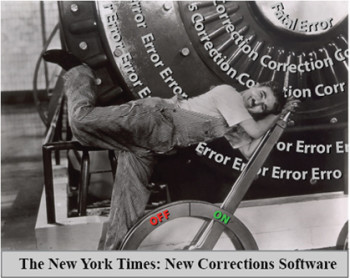
The Times’ new office is not the only thing being modernized.
Earlier this month, CheckYourFacts broke the story about the New York Times using an internal database for the first time to track errors and corrections. Editors started using the system for the first time on October 1, entering corrections retroactively from September 16.
We found out about the lack of such a system while investigating a 199-word correction attached to an article about the Greenpoint Oil spill in Brooklyn. The correction to the ExxonMobil article replaced accurate data with other studies that downplayed the effects of the spill. Suspecting that ExxonMobil may have pushed for the lengthy correction, I asked an editor if that was the case. The editor claimed that there was no database to confirm or deny my hunch.
As I continued to look into the case and for NYT staffers to answer my questions, I made contact with senior editor Greg Brock. He spoke with me at length about the new system, as well as the Jayson Blair scandal, reporters relying on Google and Wikipedia, and personnel decisions for departments that may be understaffed.
As we previously reported, the system comes two years after being recommended in the 2005 report “Preserving Our Readers’ Trust” by the Siegel committee. The report was published two years after reporter Jayson Blair was found to have plagiarized and invented information in 36 of his articles.
Part of the reason it took so long to ferret out Blair, says Brock, is that the Times never had a way of monitoring cumulative errors made by the staff. “Each department used their own system, and some didn’t use any,” he said. In Blair’s case, he worked for more than one section, and while he made errors in every one of them, the gaffes were spread out over so many parts of the paper that it didn’t raise red flags for one single editor.
“[Blair] had some 50 corrections, but no one person knew,” Brock said. “I don’t think anybody thought to check, frankly.”
At the time of the scandal, many other major dailies already correction software in place. The Boston Globe (which ironically is owned by the Times) used a tracking system for four to five years according to staff librarian Lisa Tuitte. When developing their own system, the Times consulted systems used by other papers including The Chicago Tribune to show them how it’s done, Brock says.
The new Times database holds comprehensive information about the nature of errors made by reporters and editors. The editors fill in a number of fields, starting with where the error occurred (in a column, an article, a caption, a headline, a photo, or even a byline).
Next, they enter the field “identified by,” which names the person who called the error to their attention. The paper previously had no record of this information, which is particularly important for understanding the source of more questionable corrections.
The field “originator” points to person who came up with the story in question. “Category” lists the type of correction printed, usually “For the Record,” “A Correction,” or “Editor’s Notes.” Finally, the editor enters the person responsible, and a section for miscellaneous notes for pertinent information that does not fit anywhere else.
A recent error in the paper’s Arts and Leisure section, in which Brad Pitt’s name was misspelled “Bratt,” provided an opportunity to test the new system. Although one editor made the mistake, Brock says, the index item also made it past five pairs of eyes. Now they all share blame in the notes.
Brock says the system will also allow the paper to track another common mistake made by reporters: using uncorroborated information from the Internet in their articles. “People turn to the Internet with a quick Google search, and put ‘Fact X’ in an article,” says Brock. “We know that’s happening, and we’ve asked people to please not do that.”
A partial transcript of our interview is below:
| GREG BROCK: I’m the senior editor who oversees corrections. I came back from the Washington Bureau in May of ’06. They handed me this tracking system, and told me to put it into play. So, I’ve been working on it ever since then.
ADAM KLASFELD: Is it up and running? GB: It is now. We started mid-September, officially. AK: Was there an old system before then? GB: It was never used. Actually, we started testing it with a few editors and it just sort of broke down from a technological standpoint. AK: So there was no internal database for tracking errors? GB: No. The only thing that existed was sort of department-by-department, and each department used their own system. Some didn’t use any. Of course we have our internal archive, which you could search for any correction that we’ve ever published, you know, but it’s rather laborious. If you wanted to know how many names we’ve misspelled you could do a search on given names or surnames, but that’s all it would give us. I wouldn’t call it a system, but there were departments that tracked their own errors. The purpose of this one is to pinpoint certain types of errors and how they’re happening. For instance, if we discover that “Department X” is having a lot of errors appearing in the Monday paper, it would probably tell us right off the bat that they’re lightly staffed on Sundays, and might need more help. It might be a department that, like “Culture,” for instance, would be putting out a Monday paper that has a lot of articles that are prepared in advance. Perhaps they should have come in on Friday, but maybe are coming in late on Sunday afternoon. So, we can pinpoint a problem area. One thing we’re tracking is people turning to the Internet with a quick Google search, and putting it in an article. We know that’s happening. We’ve asked people to please not do that. We’re trying to break that bad habit of going to Wikipedia, and just taking it as gospel. If there’s some particular person that appears to be having a problem with accuracy and errors, we can take a look at that, but that’s not the overriding reason. Some people always thought that we’re counting errors, but one reporter when I was the news editor in the Washington Bureau did have a fair number of errors. But it was also someone who was traveling constantly with the President, had little time to file, had no resources to check a lot of times, and wrote a story almost every day. So, you have to take that into consideration. With this system, we can even compare it by the number of words written. If someone has ten corrections, and they’re 400,000 words this year, and someone else has ten corrections, and they’ve written 30,000 words this year – there’s a difference, you know? AK: Yes. GB: I don’t know if you read our corrections much, but we often say we referred “imprecisely” to something, which means that we weren’t 100 percent wrong. I’m eager to see how many of those there are, which will tell us a little something, too. AK: What are the guidelines for such a correction? When does it cross the threshold? GB: Here’s an example. It was a sports article about Shahar Peer’s success at the United States Open yesterday. If referred “imprecisely” to one of her achievements: “Although she is indeed the second Israeli-born tennis player to advance to the quarterfinals of a Grand Slam event, she accomplished that in January at the Australian Open, not in her victory on Monday.” We didn’t say she did it at the U.S. Open, but you could certainly read it that way. Usually it’s information that somehow is omitted that would lead you to believe something. AK: What kind of fields do you enter into the database? GB: The first thing it asks for is “in what.” An article? A caption? A column? A graphic? A headline? Et cetera. The next thing is the desk, which is, you know, Education, Metropolitan, National, Foreign, whatever. And then an error identified by, whether it was a reader or a source. Then, we fill out the “originator,” which means where maybe the story idea or assignment came from. We log in what category it was – “For the Record,” “A Correction,” or “An Editor’s Notes.” We list the person responsible, and have a pull-down list of what they do – “reporter,” “photographer,” “copy editor,” “assignment editor,” “researcher,” “graphic supporter,” “map maker,” “clerk,” “news editor,” “corrections editor,” “freelancer,” and “paginator.” Some errors are production-oriented. So, those are kind of the various things there, and then there’s a list of 15 or so error types that we can choose as many or few as we need to. The basic one is it was incorrect, incomplete, or imprecise. You’ll see in the corrections sometimes “an erroneous distinction.” What that means is we’ll say that something was the first. He was the first person to do so and so. It’s the tallest building in Denver. So, that’s a distinction that we give something that turns out to be wrong. Then, there’s an “other” box that we’re going to fill in, if there’s just not a good category for it. Finally, there’s an explanation box. If we kind of have a working knowledge of how this came about, then we try to get them to think in terms of what can we do to avoid this the next time. AK: Okay. GB: We had an embarrassing error a couple of weeks ago, where we called Brad Pitt “B-r-a-t-t” on the front page of the “Arts and Leisure” section in 14-point type. That went through six editors, and nobody caught it in the computer and on the page proofs. The fact is there was one editor at the beginning who had to type in that blurb (as we call it, “index item”), and that person typed “Bratt – B-r-a-t-t.” So that person’s really responsible for the error, but the corrections editor said I’d like to put a note in here reminding everyone that five others that missed it, too. So, you can use the explanation box for stuff like that. AK: Now, this system is coming from a recommendation in the Siegal Committee in 2005? GB: I think it was ’05. Jayson Blair went in 2003. So, they met for about a year or more. AK: What’s been the trajectory of getting this in place? GB: I don’t know all the background because I was in the Washington Bureau. I never dreamed I would have this job, but once the Siegal committee recommended that, I know there was another committee of people. A copy desk chief, various kinds of editors, and a technology person met to talk about it. I think they may have even gone to a few papers. I know that The Chicago Tribune has had one for years. I don’t know if we went and looked at it or not, but I think there was some sort of fact-finding period. It was ultimately handed off to this technology person, who then started working on it and he’s not here anymore. I’m not going to use the name, but that technical part went on for two years. Just like anything else here, he had other jobs to do, and I don’t think there was anyone that was really in charge of this, per se. It kind of just like drifted along. When I got back up here in May of ’06, I started pushing, and we did get it – as far as I knew – completed. Well, the first one just collapsed technologically. We used it for a few weeks. It just wouldn’t function. It locked the editors out of it. It was just a mess. So that person went on to another paper somewhere, and a new guy came in. They put him on the project, and he and I sat down and went over the first one. I told him everything that was wrong with it, and he got it immediately. The problem with the first one is that the person designing it didn’t really have a grasp on what the thing was supposed to do. And so this kid did, and he rebuilt the entire thing. He wrote an entirely new program for it in four to six weeks, and we designed it a totally different way. Then, in mid-September, we started having training classes, and there are probably 25 people, at least. I’m still training people, but it’s rolling and people think it’s great. My boss and I have access to the entire system that we can look at anything. As I said earlier, in the old quote “system” unquote, you would just have to go around from department to department and say, “Okay, you all have sent me this reporter for three months. They made a few errors. Can you look and see what their error rate was before?” That’s what happened with Jayson Blair. He had 50 some corrections, but no one person knew. This department would use him, and he made a few errors. Then, another department would use him, and he’d made some more. And then when he got handed off in National, they didn’t know, and there was really no way to check. Plus, I don’t think anybody thought to check, frankly. So, if someone were to come to me now and say, “This person is on loan to me for three months of this project, and I’m curious,” I could look. |





